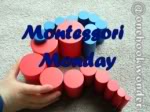"It is through our senses that we take in information and build our knowledge of the world and how it works. It is how we make sense of the world. [In Creative Development in the Child,] Montessori writes, 'What we call education of the senses is in reality an aid to the construction of the intelligence… The structure of activity in sensorial supports cognition and general development. Through matching, children observe exact sameness, and through grading, children explore the relationships between and among various objects as they build an understanding that nothing is absolute and everything depends on the context: This tile may feel rough, but it is smoother than this one. Through the sensorial activity of grading, the children explore the details through their relationship with one another. As perceptions become more refined, the quality of information she is able to take in also becomes more refined, and she is increasingly able to make more reasoned judgements and comparisons" (Andrews, 2015, p.44-45).
Andrews, Sarah Werner. (2015). The social relevance of Montessori in the first plane. The NAMTA journal, 40(2), 31-61.
Andrews, Sarah Werner. (2015). The social relevance of Montessori in the first plane. The NAMTA journal, 40(2), 31-61.














































